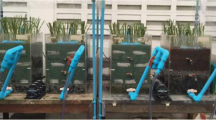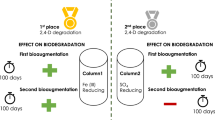Abstract
The engineered-Soil Aquifer Treatment (e-SAT) system was exploited for the biological degradation of Sulfamethoxazole (SMX) which is known to bio-accumulate in the environment. The fate of SMX in soil column was studied through laboratory simulation for a period of 90 days. About 20 ppm SMX concentration could be removed in four consecutive cycles in e-SAT. To understand the microbial community change and biological degradation of SMX in e-SAT system, metagenomic analysis was performed for the soil samples before (A-EBD) and after SMX exposure (B-EBD) in the e-SAT. Four bacterial phyla were found to be present in both the samples, with sample B-EBD showing increased abundance for Actinobacteria, Bacteroidetes, Firmicutes and decreased Proteobacterial abundance compared to A-EBD. The unclassified bacteria were found to be abundant in B-EBD compared to A-EBD. At class level, classes such as Bacilli, Negativicutes, Deltaproteobacteria, and Bacteroidia emerged in sample B-EBD owing to SMX treatment, while Burkholderiales and Nitrosomonadales appeared to be dominant at order level after SMX treatment. Furthermore, in response to SMX treatment, the family Nitrosomonadaceae appeared to be dominant. Pseudomonas was the most dominating bacterial genus in A-EBD whereas Cupriavidus dominated in sample B-EBD. Additionally, the sulfur oxidizing bacteria were enriched in the B-EBD sample, signifying efficient electron transfer and hence organic molecule degradation in the e-SAT system. Results of this study offer new insights into understanding of microbial community shift during the biodegradation of SMX.





Similar content being viewed by others
References
Aga DS (2007) Fate of pharmaceuticals in the environment and in water treatment systems. CRC Press 86–87
Alidina M, Li D, Drewes JE (2014) Investigating the role for adaptation of the microbial community to transform trace organic chemicals during managed aquifer recharge. Water Res 56:172–180
Andreozzi R, Canterino M, Marotta R, Paxeus N (2005) Antibiotic removal from wastewaters: the ozonation of amoxicillin. J Hazard Mater 122:243–250
Avisar D, Lester Y, Mamane H (2010) pH induced polychromatic UV treatment for the removal of a mixture of SMX, OTC and CIP from water. J Hazard Mater 175:1068–1074
Batt AL, Kim S, Aga DS (2007) Comparison of the occurrence of antibiotics in four full-scale wastewater treatment plants with varying designs and operations. Chemosphere 68:428–435
Baumgarten B, Jahrig J, Reemtsma T, Jekel M (2011) Long term laboratory column experiments to simulate bank filtration: factors controlling removal of sulfamethoxazole. Water Res 45:211–220
Benotti MJ, Trenholm RA, Vanderford BJ, Holady JC, Stanford BD, Snyder SA (2008) Pharmaceuticals and endocrine disrupting compounds in US drinking water. Environ Sci Technol 43:597–603
Blake GR (1965) Bulk density. Methods Soil Anal 374–390
Bouju H, Ricken B, Beffa T, Corvini PFX, Kolvenbach BA (2012) Isolation of bacterial strains capable of sulfamethoxazole mineralization from an acclimated membrane bioreactor. Appl Environ Microb 78:277–279
Bruce GM, Pleus RC, Snyder SA (2010) Toxicological relevance of pharmaceuticals in drinking water. Environ Sci Technol 44:5619–5626
Collado N, Buttiglieri G, Marti E, Ferrando-Climent L, Rodriguez-Mozaz S, Barceló D, Rodriguez-Roda I (2013) Effects on activated sludge bacterial community exposed to sulfamethoxazole. Chemosphere 93:99–106
Deng Y, Mao Y, Li B, Yang C, Zhang T (2016) Aerobic degradation of sulfadiazine by Arthrobacter spp.: kinetics, pathways, and genomic characterization. Environ Sci Technol 50:9566–9575
Drillia P, Dokianakis SN, Fountoulakis MS, Kornaros M, Stamatelatou K, Lyberatos G (2005) On the occasional biodegradation of pharmaceuticals in the activated sludge process: the example of the antibiotic sulfamethoxazole. J Hazard Mater 122:259–265
Famiglietti JS, Rudnicki JW, Rodell M (1998) Variability in surface moisture content along a hillslope transect: Rattlesnake Hill, Texas. J Hydrol 210:259–281
Gao S, Zhao Z, Xu Y, Tian J, Qi H, Lin W, Cui F (2014) Oxidation of sulfamethoxazole (SMX) by chlorine, ozone and permanganate: a comparative study. J Hazard Mater 274:258–269
Gonzalez O, Esplugas M, Sans C, Esplugas S (2008) Biodegradation of photo-Fenton pre-treated solutions of Sulfamethoxazole by aerobic communities. Molecular biology techniques applied to the determination of existing strains. J Adv Oxid Technol 11:238–245
Guizani M, Kato H, Funamizu N (2011) Assessing the removal potential of soil-aquifer treatment system (soil column) for endotoxin. J Environ Monitor 13:1716–1722
He K, Echigo S, Itoh S (2016) Effect of operating conditions in soil aquifer treatment on the removals of pharmaceuticals and personal care products. Sci Total Environ 565:672–681
Herzog B, Lemmer H, Horn H, Müller E (2013) Characterization of pure cultures isolated from sulfamethoxazole-acclimated activated sludge with respect to taxonomic identification and sulfamethoxazole biodegradation potential. BMC Microbiol 13:1
Huson DH, Auch AF, Qi J, Schuster SC (2007) MEGAN analysis of metagenomic data. Genome Res 17:377–386
Jackson ML (1973) Soil chemical analysis. Prentice Hall of India Pvt. Ltd, New Delhi 41–234
Jiang B, Cui D, Li A, Gai Z, Ma F, Yang J, Ren N (2012) Genome sequence of a cold-adaptable sulfamethoxazole-degrading bacterium, Pseudomonas psychrophila HA-4. J Bacteriol 194:5721–5721
Jiang B, Li A, Cui D, Cai R, Ma F, Wang Y (2014) Biodegradation and metabolic pathway of sulfamethoxazole by Pseudomonas psychrophila HA-4, a newly isolated cold-adapted sulfamethoxazole-degrading bacterium. Appl Microbiol Biot 98:4671–4681
Kummerer K, Henninger A (2003) Promoting resistance by the emission of antibiotics from hospitals and households into effluent. Clin Microbiol Infect 9:1203–1214
Larcher S, Yargeau V (2011) Biodegradation of sulfamethoxazole by individual and mixed bacteria. Appl Microbiol Biot 91:211–218
Lian J, Luo Z, Jin M (2013) Transport and fate of bacteria in SAT system recharged with recycling water. Int Biodeterior Biodegradation 76:98–101
Marshall KT, Morris RM (2013) Isolation of an aerobic sulfur oxidizer from the SUP05/Arctic 96BD-19 clade. ISME J 7:452–455
Meyer F, Paarmann D, D’Souza M, Olson R, Glass EM, Kubal M, Paczian T, Rodriguez A, Stevens R, Wilke A, Wilkening J (2008) The metagenomics RAST server: a public resource for the automatic phylogenetic and functional analysis of metagenomes. BMC Bioinform 9:386
More RP, Mitra S, Raju SC, Kapley A, Purohit HJ (2014) Mining and assessment of catabolic pathways in the metagenome of a common effluent treatment plant to induce the degradative capacity of biomass. Bioresour Technol 153:137–146
Muller H, Bosch J, Griebler C, Damgaard LR, Nielsen LP, Lueders T, Meckenstock RU (2016) Long-distance electron transfer by cable bacteria in aquifer sediments. ISME J 10:2010–2019
Nakada N, Yasojima M, Okayasu Y, Komori K, Suzuki Y (2010) Mass balance analysis of triclosan, diethyltoluamide, crotamiton and carbamazepine in sewage treatment plants. Water Sci Technol 61:1739–1747
Oliveros JC (2009) Venny. An interactive tool for comparing lists with Venn Diagrams. http://bioinfogp.cnb.csic.es/tools/venny/index.html
Onesios KM, Bouwer EJ (2012) Biological removal of pharmaceuticals and personal care products during laboratory soil aquifer treatment simulation with different primary substrate concentrations. Water Res 46:2365–2375
Parks DH, Tyson GW, Hugenholtz P, Beiko RG (2014) STAMP: statistical analysis of taxonomic and functional profiles. Bioinformatics 30:3123–3124
Peng X, Tan J, Tang C, Yu Y, Wang Z (2008) Multiresidue determination of fluoroquinolone, sulfonamide, trimethoprim, and chloramphenicol antibiotics in urban waters in China. Environ Toxicol Chem 27:73–79
Peng X, Zhang K, Tang C, Huang Q, Yu Y, Cui J (2011) Distribution pattern, behavior, and fate of antibacterials in urban aquatic environments in South China. J Environ Monitor 13:446–454
Reis PJ, Reis AC, Ricken B, Kolvenbach BA, Manaia CM, Corvini PF, Nunes OC (2014) Biodegradation of sulfamethoxazole and other sulfonamides by Achromobacter denitrificans PR1. J Hazard Mater 280:741–749
Rivas FJ, Beltrán FJ, Encinas A (2012) Removal of emergent contaminants: integration of ozone and photocatalysis. J Environ Manage 100:10–15
Rodayan A, Roy R, Yargeau V (2010) Oxidation products of sulfamethoxazole in ozonated secondary effluent. J Hazard Mater 177:237–243
Rodriguez-Escales P, Sanchez-Vila X (2016) Fate of sulfamethoxazole in groundwater: conceptualizing and modeling metabolite formation under different redox conditions. Water Res 105:540–550
Schaffer M, Kroger KF, Nodler K, Ayora C, Carrera J, Hernandez M, Licha T (2015) Influence of a compost layer on the attenuation of 28 selected organic micropollutants under realistic soil aquifer treatment conditions: insights from a large scale column experiment. Water Res 74:110–121
Szczepanowski R, Linke B, Krahn I, Gartemann KH, Gutzkow T, Eichler W, Puhler A, Schluter A (2009) Detection of 140 clinically relevant antibiotic resistance genes in the plasmid metagenome of wastewater treatment plant bacteria showing reduced susceptibility to selected antibiotics. Microbiology 155:2306–2319
Valhondo C, Carrera J, Ayora C, Tubau I, Martinez-Landa L, Nodler K, Licha T (2015) Characterizing redox conditions and monitoring attenuation of selected pharmaceuticals during artificial recharge through a reactive layer. Sci Tot Environ 512:240–250
Wang L, Liu Y, Ma J, Zhao F (2016) Rapid degradation of sulphamethoxazole and the further transformation of 3-amino-5-methylisoxazole in a microbial fuel cell. Water Res 88:322–328
Wei L, Li S, Noguera DR, Qin K, Jiang J, Zhao Q, Cui F (2015) Dissolved organic matter removal during coal slag additive soil aquifer treatment for secondary effluent recharging: contribution of aerobic biodegradation. J Environ Manage 156:158–166
Yadav TC, Pal RR, Shastri S, Jadeja NB, Kapley A (2015) Comparative metagenomics demonstrating different degradative capacity of activated biomass treating hydrocarbon contaminated wastewater. Bioresour Technol 188:24–32
Yafa C, Farmer JG (2006) A comparative study of acid-extractable and total digestion methods for the determination of inorganic elements in peat material by inductively coupled plasma-optical emission spectrometry. Anal Chim Acta 557:296–303
Yan C, Dinh QT, Chevreuil M, Garnier J, Roose-Amsaleg C, Labadie P, Laverman AM (2013) The effect of environmental and therapeutic concentrations of antibiotics on nitrate reduction rates in river sediment. Water Res 47:3654–3662
Yu K, Zhang T (2012) Metagenomic and metatranscriptomic analysis of microbial community structure and gene expression of activated sludge. PLoS ONE. doi:10.1371/journal.pone.0038183
Zhang Y, Geng J, Ma H, Ren H, Xu K, Ding L (2016) Characterization of microbial community and antibiotic resistance genes in activated sludge under tetracycline and sulfamethoxazole selection pressure. Sci Total Environ 571:479–486
Acknowledgements
The authors are thankful to Council of Scientific and Industrial Research for providing necessary facilities and financial support to carry out this research. Ashwinkumar P. Rudrashetti is grateful to University Grant Commission (UGC), India for the award of a junior research fellowship. The manuscript represents communication number, CSIR-NEERI/KRC/2016/AUG/EBGD/3.
Author information
Authors and Affiliations
Corresponding author
Ethics declarations
Conflict of interest
The authors declare no conflict of interest.
Electronic supplementary material
Below is the link to the electronic supplementary material.
Rights and permissions
About this article
Cite this article
Rudrashetti, A.P., Jadeja, N.B., Gandhi, D. et al. Microbial population shift caused by sulfamethoxazole in engineered-Soil Aquifer Treatment (e-SAT) system. World J Microbiol Biotechnol 33, 121 (2017). https://doi.org/10.1007/s11274-017-2284-8
Received:
Accepted:
Published:
DOI: https://doi.org/10.1007/s11274-017-2284-8




